
nVIDIA. CUDA C PROGRAMMING GUIDE PG-02829-001v9.2|May2018 Design Guide
CUDA C PROGRAMMING GUIDE PG-02829-001_v9.2 | May 2018 Design Guide
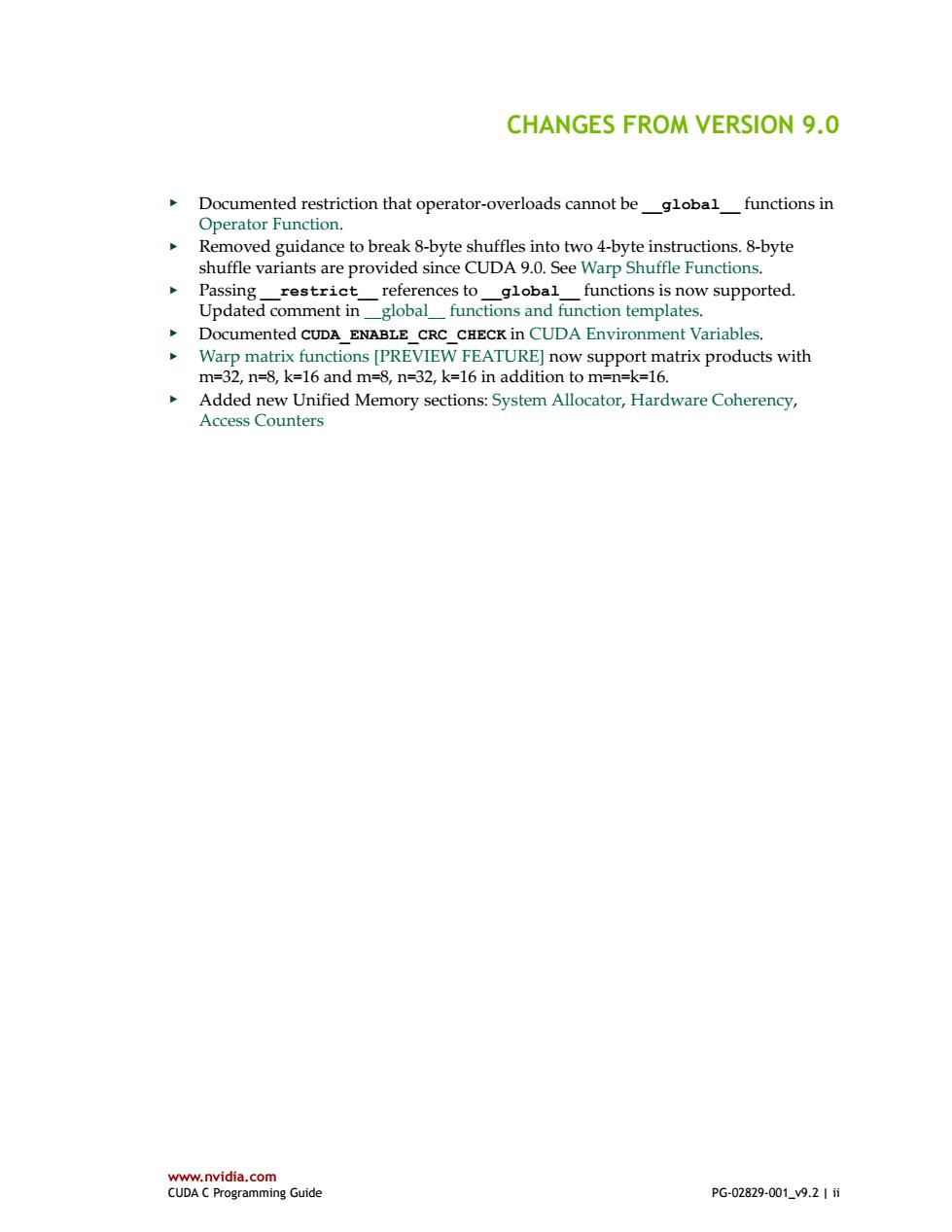
CHANGES FROM VERSION 9.0 Documented restriction that operator-overloads cannot be global functions in Operator Function. Removed guidance to break 8-byte shuffles into two 4-byte instructions.8-byte shuffle variants are provided since CUDA 9.0.See Warp Shuffle Functions. Passing restrict references to global functions is now supported. Updated comment in globalfunctions and function templates. Documented CUDA ENABLE CRC CHECK in CUDA Environment Variables. Warp matrix functions [PREVIEW FEATURE]now support matrix products with m=32,n=8,k=16 and m=8,n=32,k=16 in addition to m=n=k=16. Added new Unified Memory sections:System Allocator,Hardware Coherency, Access Counters www.nvidia.com CUDA C Programming Guide PG-02829-001v9.21ii
www.nvidia.com CUDA C Programming Guide PG-02829-001_v9.2 | ii CHANGES FROM VERSION 9.0 ‣ Documented restriction that operator-overloads cannot be __global__ functions in Operator Function. ‣ Removed guidance to break 8-byte shuffles into two 4-byte instructions. 8-byte shuffle variants are provided since CUDA 9.0. See Warp Shuffle Functions. ‣ Passing __restrict__ references to __global__ functions is now supported. Updated comment in __global__ functions and function templates. ‣ Documented CUDA_ENABLE_CRC_CHECK in CUDA Environment Variables. ‣ Warp matrix functions [PREVIEW FEATURE] now support matrix products with m=32, n=8, k=16 and m=8, n=32, k=16 in addition to m=n=k=16. ‣ Added new Unified Memory sections: System Allocator, Hardware Coherency, Access Counters
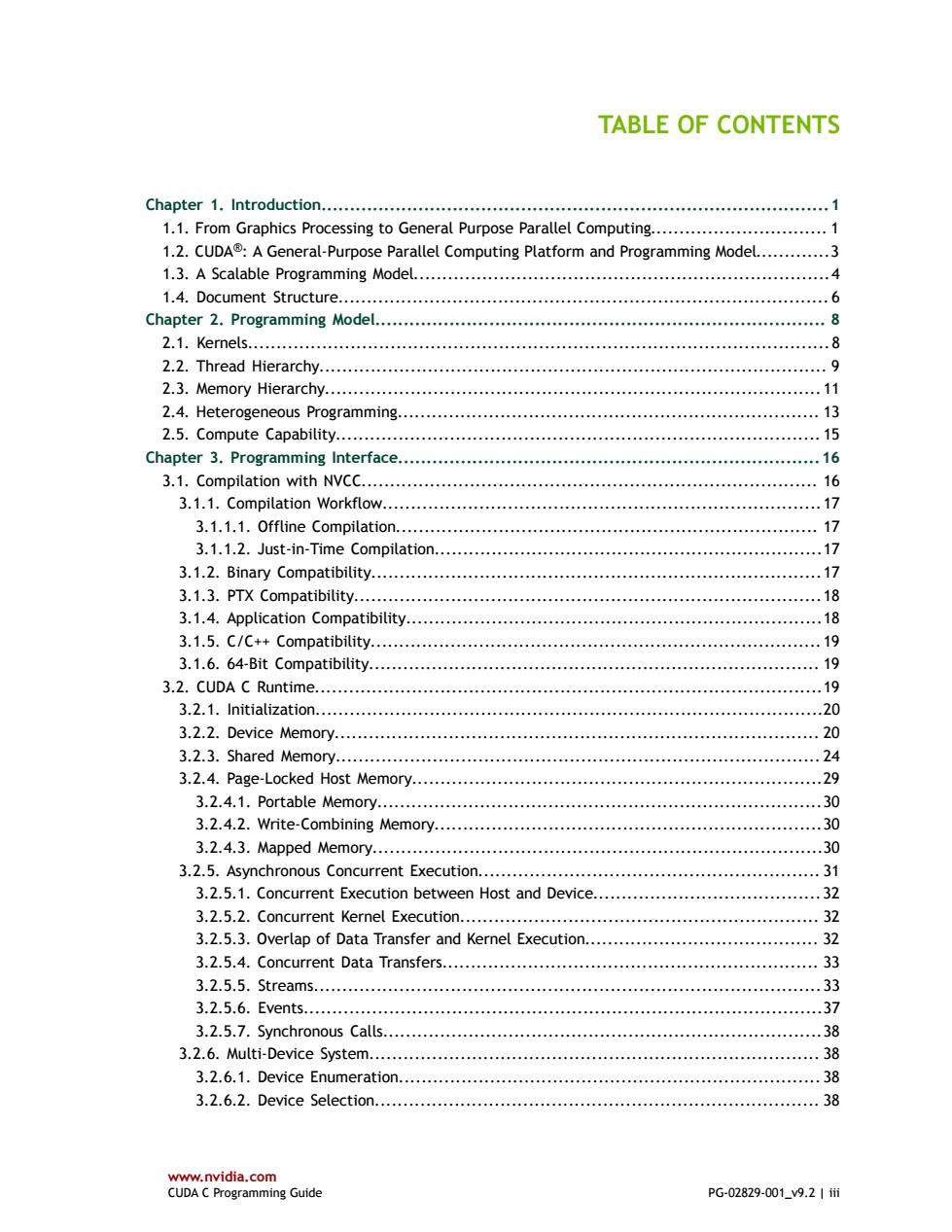
TABLE OF CONTENTS Chapter 1.Introduction..1 1.1.From Graphics Processing to General Purpose Parallel Computing...............................1 1.2.CUDA:A General-Purpose Parallel Computing Platform and Programming Model.............3 1.3.A Scalable Programming Model.....................................4 1.4.Document Structure....................... 6 8 Chapter 2.Programming Model................ 2.1.Kernets............. .8 2.2.Thread Hierarchy........................... 9 2.3.Memory Hierarchy................... .11 2.4.Heterogeneous Programming.................. 3 2.5.Compute Capability.............. 15 Chapter 3.Programming Interface........ …16 3.1.Compilation with NVCC............ 16 3.1.1.Compilation Workflow.... .17 3.1.1.1.Offline Compilation....... 17 3.1.1.2.Just-in-Time Compilation.. .17 3.1.2.Binary Compatibility............. .17 3.1.3.PTX Compatibility............... 18 3.1.4.Application Compatibility........... 18 3.1.5.C/C++Compatibility...... .19 3.1.6.64-Bit Compatibility............... 19 3.2.CUDA C Runtime.… .19 3.2.1.Initiatization.................... …20 3.2.2.Device Memory.… 20 3.2.3.Shared Memory.................. .24 3.2.4.Page-Locked Host Memory..................... 29 3.2.4.1.Portable Memory.................... .30 3.2.4.2.Write-combining Memory.......30 3.2.4.3.Mapped Memory.................. 30 3.2.5.Asynchronous Concurrent Execution............... .31 3.2.5.1.Concurrent Execution between Host and Device..... .32 3.2.5.2.Concurrent Kernel Execution......................... .32 3.2.5.3.Overlap of Data Transfer and Kernel Execution.... 32 3.2.5.4.Concurrent Data Transfers...................... 33 3.2.5.5.Streams....... .33 3.2.5.6.Events.… 37 3.2.5.7.Synchronous Calls.... .38 3.2.6.Multi-Device System...................... .38 3.2.6.1.Device Enumeration...... .38 3.2.6.2.Device Selection..................38 www.nvidia.com CUDA C Programming Guide PG-02829-001_v9.2|ii
www.nvidia.com CUDA C Programming Guide PG-02829-001_v9.2 | iii TABLE OF CONTENTS Chapter 1. Introduction.........................................................................................1 1.1. From Graphics Processing to General Purpose Parallel Computing............................... 1 1.2. CUDA®: A General-Purpose Parallel Computing Platform and Programming Model.............3 1.3. A Scalable Programming Model.........................................................................4 1.4. Document Structure...................................................................................... 6 Chapter 2. Programming Model............................................................................... 8 2.1. Kernels......................................................................................................8 2.2. Thread Hierarchy......................................................................................... 9 2.3. Memory Hierarchy....................................................................................... 11 2.4. Heterogeneous Programming.......................................................................... 13 2.5. Compute Capability..................................................................................... 15 Chapter 3. Programming Interface..........................................................................16 3.1. Compilation with NVCC................................................................................ 16 3.1.1. Compilation Workflow.............................................................................17 3.1.1.1. Offline Compilation.......................................................................... 17 3.1.1.2. Just-in-Time Compilation....................................................................17 3.1.2. Binary Compatibility...............................................................................17 3.1.3. PTX Compatibility..................................................................................18 3.1.4. Application Compatibility.........................................................................18 3.1.5. C/C++ Compatibility............................................................................... 19 3.1.6. 64-Bit Compatibility............................................................................... 19 3.2. CUDA C Runtime.........................................................................................19 3.2.1. Initialization.........................................................................................20 3.2.2. Device Memory..................................................................................... 20 3.2.3. Shared Memory..................................................................................... 24 3.2.4. Page-Locked Host Memory........................................................................29 3.2.4.1. Portable Memory..............................................................................30 3.2.4.2. Write-Combining Memory....................................................................30 3.2.4.3. Mapped Memory...............................................................................30 3.2.5. Asynchronous Concurrent Execution............................................................ 31 3.2.5.1. Concurrent Execution between Host and Device........................................32 3.2.5.2. Concurrent Kernel Execution............................................................... 32 3.2.5.3. Overlap of Data Transfer and Kernel Execution......................................... 32 3.2.5.4. Concurrent Data Transfers.................................................................. 33 3.2.5.5. Streams.........................................................................................33 3.2.5.6. Events...........................................................................................37 3.2.5.7. Synchronous Calls.............................................................................38 3.2.6. Multi-Device System............................................................................... 38 3.2.6.1. Device Enumeration.......................................................................... 38 3.2.6.2. Device Selection.............................................................................. 38

3.2.6.3.Stream and Event Behavior..... .39 3.2.6.4.Peer-to-Peer Memory Access.....39 3.2.6.5.Peer-to-Peer Memory Copy............ .40 3.2.7.Unified Virtual Address Space............................. 41 3.2.8.Interprocess Communication...... 41 3.2.9.Error checking..................... …42 3.2.10.Call Stack.… …42 3.2.11.Texture and Surface Memory......... 42 3.2.11.1.Texture Memory................ 43 3.2.11.2.Surface Memory.............. 52 3.2.11.3.CUDA Arrays................ .56 3.2.11.4.Read/Write Coherency..... 56 3.2.12.Graphics Interoperability.......... .56 3.2.12.1.OpenGL Interoperability.... 57 3.2.12.2.Direct3D Interoperability...... .59 3.2.12.3.SLI Interoperability....... 65 3.3.Versioning and Compatibility............... .66 3.4.Compute Modes.................... 67 3.5.Mode Switches...68 3.6.Tesla Compute Cluster Mode for Windows... 68 Chapter 4.Hardware Implementation.................. 0…70 4.1.SIMT Architecture................. 70 4.2.Hardware Multithreading............... .72 Chapter 5.Performance Guidelines................. .74 5.1.Overall Performance Optimization Strategies.. 74 5.2.Maximize Utilization.......................... .74 5.2.1.Application Level.................... .74 5.2.2.Device Level.… .75 5.2.3.Multiprocessor Level...... .75 5.2.3.1.Occupancy Calculator............ .77 5.3.Maximize Memory Throughput...... 79 5.3.1.Data Transfer between Host and Device. 80 5.3.2.Device Memory Accesses............ .81 5.4.Maximize Instruction Throughput............ .85 5.4.1.Arithmetic Instructions......... .85 5.4.2.Control Flow Instructions.............. .89 5.4.3.Synchronization Instruction... .90 Appendix A.CUDA-Enabled GPUs............ …91 Appendix B.C Language Extensions..... .92 B.1.Function Execution Space Specifiers .92 B.1.1.device_ 92 B.1.2.global 92 B.1.3.ho5t. 93 www.nvidia.com CUDA C Programming Guide PG-02829-001_v9.21iV
www.nvidia.com CUDA C Programming Guide PG-02829-001_v9.2 | iv 3.2.6.3. Stream and Event Behavior................................................................. 39 3.2.6.4. Peer-to-Peer Memory Access................................................................39 3.2.6.5. Peer-to-Peer Memory Copy..................................................................40 3.2.7. Unified Virtual Address Space................................................................... 41 3.2.8. Interprocess Communication..................................................................... 41 3.2.9. Error Checking......................................................................................42 3.2.10. Call Stack.......................................................................................... 42 3.2.11. Texture and Surface Memory................................................................... 42 3.2.11.1. Texture Memory............................................................................. 43 3.2.11.2. Surface Memory............................................................................. 52 3.2.11.3. CUDA Arrays..................................................................................56 3.2.11.4. Read/Write Coherency..................................................................... 56 3.2.12. Graphics Interoperability........................................................................56 3.2.12.1. OpenGL Interoperability................................................................... 57 3.2.12.2. Direct3D Interoperability...................................................................59 3.2.12.3. SLI Interoperability..........................................................................65 3.3. Versioning and Compatibility.......................................................................... 66 3.4. Compute Modes..........................................................................................67 3.5. Mode Switches........................................................................................... 68 3.6. Tesla Compute Cluster Mode for Windows.......................................................... 68 Chapter 4. Hardware Implementation......................................................................70 4.1. SIMT Architecture....................................................................................... 70 4.2. Hardware Multithreading...............................................................................72 Chapter 5. Performance Guidelines........................................................................ 74 5.1. Overall Performance Optimization Strategies...................................................... 74 5.2. Maximize Utilization.................................................................................... 74 5.2.1. Application Level...................................................................................74 5.2.2. Device Level........................................................................................ 75 5.2.3. Multiprocessor Level...............................................................................75 5.2.3.1. Occupancy Calculator........................................................................ 77 5.3. Maximize Memory Throughput........................................................................ 79 5.3.1. Data Transfer between Host and Device....................................................... 80 5.3.2. Device Memory Accesses..........................................................................81 5.4. Maximize Instruction Throughput.....................................................................85 5.4.1. Arithmetic Instructions............................................................................85 5.4.2. Control Flow Instructions......................................................................... 89 5.4.3. Synchronization Instruction.......................................................................90 Appendix A. CUDA-Enabled GPUs........................................................................... 91 Appendix B. C Language Extensions........................................................................92 B.1. Function Execution Space Specifiers.................................................................92 B.1.1. __device__.......................................................................................... 92 B.1.2. __global__...........................................................................................92 B.1.3. __host__............................................................................................. 93

B.1.4.noinline and forceinline. 93 B.2.Variable Memory Space Specifiers............... 93 B.2.1._device_… .94 B.2.2.constant_ 94 B.2.3.shared_… .94 B.2.4.managed.… ..95 B.2.5.restrict_… .95 B.3.Built-in Vector Types.............. 97 B.3.1.char,short,int,long,longlong,float,double .97 B.3.2.dim3.… .98 B.4.Built-in Variables....................... 98 B.4.1.gridDim..… 98 B.4.2.blockldx.… .98 B.4.3.blockDim.............. .98 B.4.4.threadldx................... 99 B.4.5.warpSize.......... 99 B.5.Memory Fence Functions................. 99 B.6.Synchronization Functions.... ,102 B.7.Mathematical Functions................ .103 B.8.Texture Functions.......... .103 B.8.1.Texture object APl.......... …103 B.8.1.1.tex1Dfetch()...... ..103 B.8.1.2.tex1D0.… 103 B.8.1.3.tex1DLod0.… .103 B.8.1.4.tex1DGrad()........... 104 B.8.1.5.tex2D0.. 104 B.8.1.6.tex2DLod0.… ….104 B.8.1.7.tex2DGrad()........ 104 B.8.1.8.tex3D0.… ..104 B.8.1.9.tex3DLod0… .104 B.8.1.10.tex3DGrad().... ..105 B.8.1.11.tex1DLayered()........ .105 B.8.1.12.tex1DLayeredLod().. .105 B.8.1.13.tex1DLayeredGrad(). 105 B.8.1.14.tex2DLayered()...... 105 B.8.1.15.tex2DLayeredLod()......... .105 B.8.1.16.tex2DLayeredGrad()... .106 B.8.1.17.texCubemap()............ …106 B.8.1.18.texCubemapLod()...... .106 B.8.1.19.texCubemapLayered()...... .106 B.8.1.20.texCubemapLayeredLod(). .106 B.8.1.21.tex2Dgather()............. .106 B.8.2.Texture Reference API......... .107 www.nvidia.com CUDA C Programming Guide PG-02829-001_9.21V
www.nvidia.com CUDA C Programming Guide PG-02829-001_v9.2 | v B.1.4. __noinline__ and __forceinline__............................................................... 93 B.2. Variable Memory Space Specifiers....................................................................93 B.2.1. __device__.......................................................................................... 94 B.2.2. __constant__........................................................................................94 B.2.3. __shared__.......................................................................................... 94 B.2.4. __managed__....................................................................................... 95 B.2.5. __restrict__......................................................................................... 95 B.3. Built-in Vector Types................................................................................... 97 B.3.1. char, short, int, long, longlong, float, double................................................ 97 B.3.2. dim3..................................................................................................98 B.4. Built-in Variables........................................................................................ 98 B.4.1. gridDim.............................................................................................. 98 B.4.2. blockIdx..............................................................................................98 B.4.3. blockDim.............................................................................................98 B.4.4. threadIdx............................................................................................ 99 B.4.5. warpSize............................................................................................. 99 B.5. Memory Fence Functions...............................................................................99 B.6. Synchronization Functions............................................................................102 B.7. Mathematical Functions...............................................................................103 B.8. Texture Functions......................................................................................103 B.8.1. Texture Object API...............................................................................103 B.8.1.1. tex1Dfetch()..................................................................................103 B.8.1.2. tex1D()........................................................................................ 103 B.8.1.3. tex1DLod()....................................................................................103 B.8.1.4. tex1DGrad().................................................................................. 104 B.8.1.5. tex2D()........................................................................................ 104 B.8.1.6. tex2DLod()....................................................................................104 B.8.1.7. tex2DGrad().................................................................................. 104 B.8.1.8. tex3D()........................................................................................ 104 B.8.1.9. tex3DLod()....................................................................................104 B.8.1.10. tex3DGrad().................................................................................105 B.8.1.11. tex1DLayered()............................................................................. 105 B.8.1.12. tex1DLayeredLod().........................................................................105 B.8.1.13. tex1DLayeredGrad()....................................................................... 105 B.8.1.14. tex2DLayered()............................................................................. 105 B.8.1.15. tex2DLayeredLod().........................................................................105 B.8.1.16. tex2DLayeredGrad()....................................................................... 106 B.8.1.17. texCubemap().............................................................................. 106 B.8.1.18. texCubemapLod().......................................................................... 106 B.8.1.19. texCubemapLayered().....................................................................106 B.8.1.20. texCubemapLayeredLod()................................................................ 106 B.8.1.21. tex2Dgather()...............................................................................106 B.8.2. Texture Reference API...........................................................................107
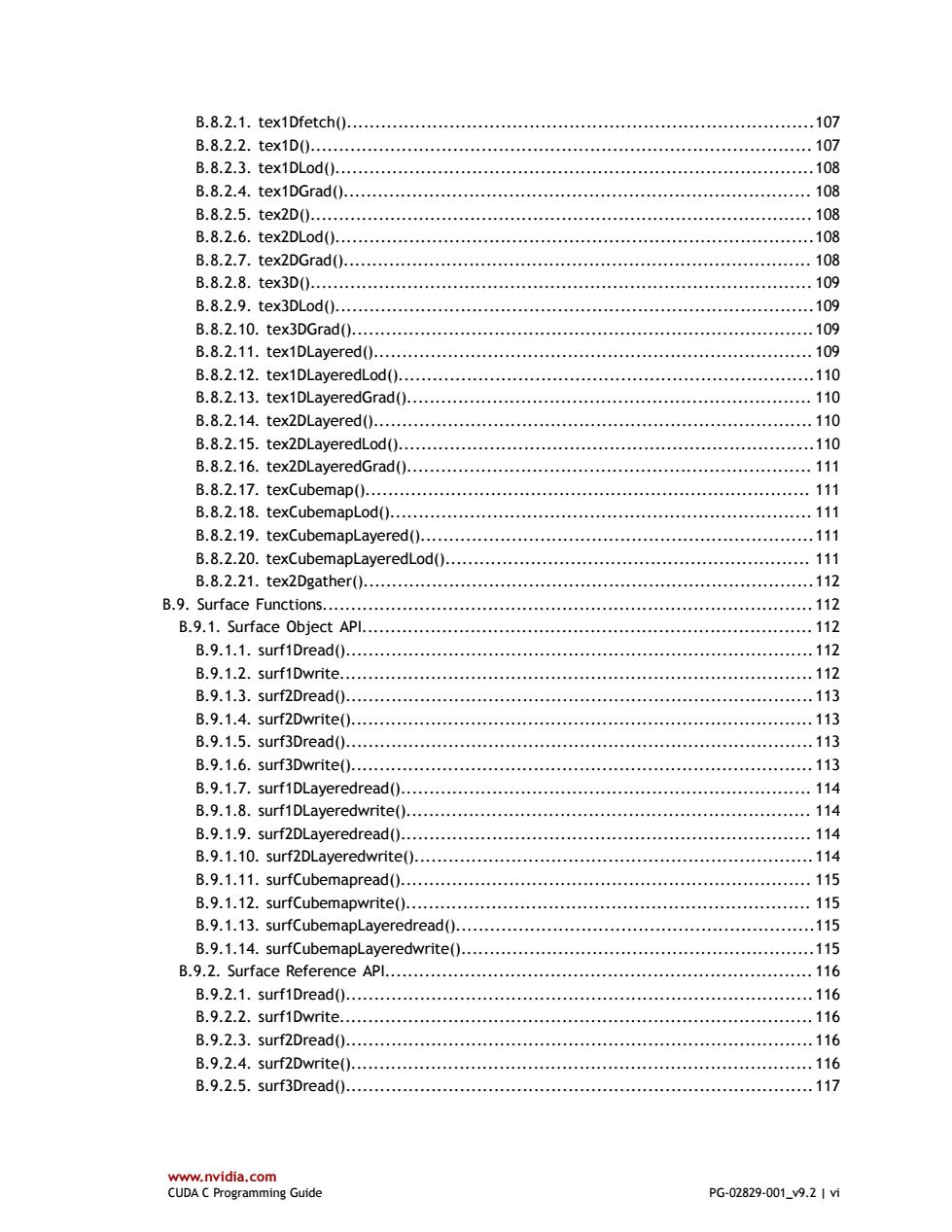
B.8.2.1.tex1Dfetch(). .107 B.8.2.2.tex1D0.… 107 B.8.2.3.tex1DLod()....... .108 B.8.2.4.tex1DGrad()............... .108 B.8.2.5.tex2D0.. 108 B.8.2.6.tex2DLod().............. .108 B.8.2.7.tex2DGrad().......... ...108 B.8.2.8.tex3D0. …109 B.8.2.9.tex3DLod()............ ..109 B.8.2.10.tex3DGrad()............ .109 B.8.2.11.tex1DLayered()......... .109 B.8.2.12.tex1DLayeredLod().. .110 B.8.2.13.tex1DLayeredGrad()..... .110 B.8.2.14.tex2DLayered()...... ,110 B.8.2.15.tex2DLayeredLod()...... .110 B.8.2.16.tex2DLayeredGrad()... 111 B.8.2.17.texCubemap().............. .111 B.8.2.18.texCubemapLod()..... 111 B.8.2.19.texCubemapLayered()............ ….111 B.8.2.20.texCubemapLayeredLod(). …111 B.8.2.21.tex2Dgather()............... .112 B.9.Surface Functions............ .112 B.9.1.Surface object APl............... .112 B.9.1.1.surf1Dread()................ .112 B.9.1.2.surf1Dwrite............. .112 B.9.1.3.surf2Dread()............. .113 B.9.1.4.surf2Dwrite()............ ,113 B.9.1.5.surf3Dread()............ .113 B.9.1.6.surf3Dwrite().... .113 B.9.1.7.surf1DLayeredread().... 114 B.9.1.8.surf1DLayeredwrite()... 114 B.9.1.9.surf2DLayeredread()..... .114 B.9.1.10.surf2DLayeredwrite() .114 B.9.1.11.surfCubemapread()......... .115 B.9.1.12.surfCubemapwrite().... 115 B.9.1.13.surfCubemapLayeredread() .115 B.9.1.14.surfCubemapLayeredwrite() .115 B.9.2.Surface Reference APl.... .116 B.9.2.1.surf1Dread().......... .116 B.9.2.2.surf1Dwrite............. …116 B.9.2.3.surf2Dread().......... 116 B.9.2.4.surf2Dwrite()........ …116 B.9.2.5.surf3Dread()....... .117 www.nvidia.com CUDA C Programming Guide PG-02829-001_v9.21
www.nvidia.com CUDA C Programming Guide PG-02829-001_v9.2 | vi B.8.2.1. tex1Dfetch()..................................................................................107 B.8.2.2. tex1D()........................................................................................ 107 B.8.2.3. tex1DLod()....................................................................................108 B.8.2.4. tex1DGrad().................................................................................. 108 B.8.2.5. tex2D()........................................................................................ 108 B.8.2.6. tex2DLod()....................................................................................108 B.8.2.7. tex2DGrad().................................................................................. 108 B.8.2.8. tex3D()........................................................................................ 109 B.8.2.9. tex3DLod()....................................................................................109 B.8.2.10. tex3DGrad().................................................................................109 B.8.2.11. tex1DLayered()............................................................................. 109 B.8.2.12. tex1DLayeredLod().........................................................................110 B.8.2.13. tex1DLayeredGrad()....................................................................... 110 B.8.2.14. tex2DLayered()............................................................................. 110 B.8.2.15. tex2DLayeredLod().........................................................................110 B.8.2.16. tex2DLayeredGrad()....................................................................... 111 B.8.2.17. texCubemap().............................................................................. 111 B.8.2.18. texCubemapLod().......................................................................... 111 B.8.2.19. texCubemapLayered().....................................................................111 B.8.2.20. texCubemapLayeredLod()................................................................ 111 B.8.2.21. tex2Dgather()...............................................................................112 B.9. Surface Functions...................................................................................... 112 B.9.1. Surface Object API............................................................................... 112 B.9.1.1. surf1Dread()..................................................................................112 B.9.1.2. surf1Dwrite................................................................................... 112 B.9.1.3. surf2Dread()..................................................................................113 B.9.1.4. surf2Dwrite()................................................................................. 113 B.9.1.5. surf3Dread()..................................................................................113 B.9.1.6. surf3Dwrite()................................................................................. 113 B.9.1.7. surf1DLayeredread()........................................................................ 114 B.9.1.8. surf1DLayeredwrite()....................................................................... 114 B.9.1.9. surf2DLayeredread()........................................................................ 114 B.9.1.10. surf2DLayeredwrite()......................................................................114 B.9.1.11. surfCubemapread()........................................................................ 115 B.9.1.12. surfCubemapwrite()....................................................................... 115 B.9.1.13. surfCubemapLayeredread()...............................................................115 B.9.1.14. surfCubemapLayeredwrite()..............................................................115 B.9.2. Surface Reference API........................................................................... 116 B.9.2.1. surf1Dread()..................................................................................116 B.9.2.2. surf1Dwrite................................................................................... 116 B.9.2.3. surf2Dread()..................................................................................116 B.9.2.4. surf2Dwrite()................................................................................. 116 B.9.2.5. surf3Dread()..................................................................................117

B.9.2.6.surf3Dwrite()..... ,117 B.9.2.7.surf1DLayeredread()............. 117 B.9.2.8.surf1DLayeredwrite().... ..117 B.9.2.9.surf2DLayeredread()............ 118 B.9.2.10.surf2DLayeredwrite(). .118 B.9.2.11.surfCubemapread()............ 118 B.9.2.12.surfCubemapwrite().......... .118 B.9.2.13.surfCubemapLayeredread(). .119 B.9.2.14.surfCubemapLayeredwrite(). .119 B.10.Read-Only Data Cache Load Function. .119 B.11.Time Function.......................... ...119 B.12.Atomic Functions........... 120 B.12.1.Arithmetic Functions......... 121 B.12.1.1.atomicAdd().... .121 B.12.1.2.atomicSub0..... .121 B.12.1.3.atomicExch()... .122 B.12.1.4.atomicMin()............. .122 B.12.1.5.atomicMax()... ..122 B.12.1.6.atomiclnc().............. .122 B.12.1.7.atomicDec()... .123 B.12.1.8.atomiccAS()........ .123 B.12.2.Bitwise Functions... 123 B.12.2.1.atomicAnd().......... .123 B.12.2.2.atomic0r0.… 123 B.12.2.3.atomicXor().......... 124 B.13.Warp Vote Functions........... 124 B.14.Warp Match Functions...... 125 B.14.1.Synop5ys.… 125 B.14.2.Description...... 125 B.15.Warp Shuffle Functions...... .126 B.15.1.Synopsis.… 126 B.15.2.Description................. 126 B.15.3.Return Value............... 127 B.15.4.Notes..… 128 B.15.5.xamples..… 128 B.15.5.1.Broadcast of a single value across a warp................................... 128 B.15.5.2.Inclusive plus-scan across sub-partitions of 8 threads.... .129 B.15.5.3.Reduction across a warp...................... 129 B.16.Warp matrix functions [PREVIEW FEATURE].......... .129 B.16.1.Description.......... 130 B.16.2.xample.… 132 B.17.Profiler Counter Function............. 132 B.18.Assertion............... 133 www.nvidia.com CUDA C Programming Guide PG-02829-001_v9.2|vii
www.nvidia.com CUDA C Programming Guide PG-02829-001_v9.2 | vii B.9.2.6. surf3Dwrite()................................................................................. 117 B.9.2.7. surf1DLayeredread()........................................................................ 117 B.9.2.8. surf1DLayeredwrite()....................................................................... 117 B.9.2.9. surf2DLayeredread()........................................................................ 118 B.9.2.10. surf2DLayeredwrite()......................................................................118 B.9.2.11. surfCubemapread()........................................................................ 118 B.9.2.12. surfCubemapwrite()....................................................................... 118 B.9.2.13. surfCubemapLayeredread()...............................................................119 B.9.2.14. surfCubemapLayeredwrite()..............................................................119 B.10. Read-Only Data Cache Load Function.............................................................119 B.11. Time Function.........................................................................................119 B.12. Atomic Functions..................................................................................... 120 B.12.1. Arithmetic Functions........................................................................... 121 B.12.1.1. atomicAdd().................................................................................121 B.12.1.2. atomicSub()................................................................................. 121 B.12.1.3. atomicExch()................................................................................122 B.12.1.4. atomicMin()................................................................................. 122 B.12.1.5. atomicMax().................................................................................122 B.12.1.6. atomicInc()..................................................................................122 B.12.1.7. atomicDec().................................................................................123 B.12.1.8. atomicCAS().................................................................................123 B.12.2. Bitwise Functions............................................................................... 123 B.12.2.1. atomicAnd().................................................................................123 B.12.2.2. atomicOr().................................................................................. 123 B.12.2.3. atomicXor()................................................................................. 124 B.13. Warp Vote Functions................................................................................. 124 B.14. Warp Match Functions............................................................................... 125 B.14.1. Synopsys.......................................................................................... 125 B.14.2. Description....................................................................................... 125 B.15. Warp Shuffle Functions..............................................................................126 B.15.1. Synopsis........................................................................................... 126 B.15.2. Description....................................................................................... 126 B.15.3. Return Value..................................................................................... 127 B.15.4. Notes.............................................................................................. 128 B.15.5. Examples..........................................................................................128 B.15.5.1. Broadcast of a single value across a warp............................................ 128 B.15.5.2. Inclusive plus-scan across sub-partitions of 8 threads............................... 129 B.15.5.3. Reduction across a warp................................................................. 129 B.16. Warp matrix functions [PREVIEW FEATURE]......................................................129 B.16.1. Description....................................................................................... 130 B.16.2. Example...........................................................................................132 B.17. Profiler Counter Function........................................................................... 132 B.18. Assertion............................................................................................... 133
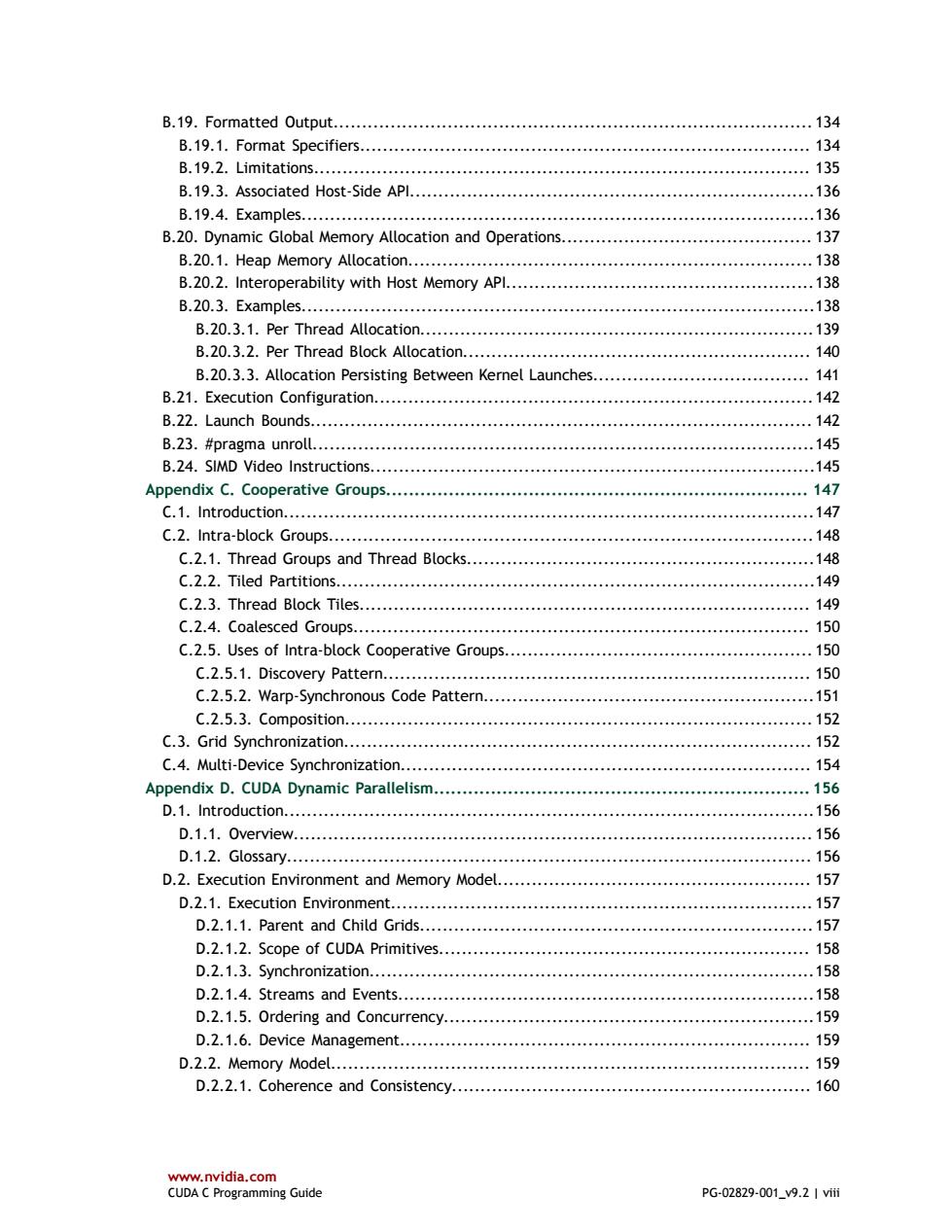
B.19.Formatted Output.......... 134 B.19.1.Format Specifiers............... 134 B.19.2.Limitations......... 135 B.19.3.Associated Host-Side APl.........136 B.19.4.Examples...... .136 B.20.Dynamic Global Memory Allocation and Operations.137 B.20.1.Heap Memory Allocation....................138 B.20.2.Interoperability with Host Memory APl..... .138 B.20.3.Examples.… 138 B.20.3.1.Per Thread Allocation.................... .139 B.20.3.2.Per Thread Block Allocation............... …140 B.20.3.3.Allocation Persisting Between Kernel Launches. 141 B.21.Execution Configuration........................ .142 B.22.Launch Bounds..… .142 B.23.#pragma unrou........ .145 B.24.SIMD Video Instructions................. .145 Appendix C.Cooperative Groups......147 C.1.Introduction.................. ..147 C.2.Intra-block Groups...........148 C.2.1.Thread Groups and Thread Blocks... .148 C.2.2.Tiled Partitions......... ….149 C.2.3.Thread Block Tiles................ 149 C.2.4.Coalesced Groups......... 150 C.2.5.Uses of Intra-block Cooperative Groups....... 150 C.2.5.1.Discovery Pattern................. 150 C.2.5.2.Warp-Synchronous Code Pattern....... .151 C.2.5.3.Composition................... 152 C.3.Grid Synchronization.................... 152 C.4.Multi-Device Synchronization.... 154 Appendix D.CUDA Dynamic Parallelism...... …156 D.1.Introduction..… .156 D.1.1.Overview................. ...156 D.1.2.Glossary..… 156 D.2.Execution Environment and Memory Model. 157 D.2.1.Execution Environment............. 157 D.2.1.1.Parent and Child Grids.............. .157 D.2.1.2.Scope of CUDA Primitives.... 158 D.2.1.3.Synchronization............... …158 D.2.1.4.Streams and Events......... .158 D.2.1.5.Ordering and Concurrency........ .159 D.2.1.6.Device Management............ 159 D.2.2.Memory Model..… 159 D.2.2.1.Coherence and Consistency....... .160 www.nvidia.com CUDA C Programming Guide PG-02829-001_v9.21iii
www.nvidia.com CUDA C Programming Guide PG-02829-001_v9.2 | viii B.19. Formatted Output.................................................................................... 134 B.19.1. Format Specifiers............................................................................... 134 B.19.2. Limitations....................................................................................... 135 B.19.3. Associated Host-Side API.......................................................................136 B.19.4. Examples..........................................................................................136 B.20. Dynamic Global Memory Allocation and Operations............................................ 137 B.20.1. Heap Memory Allocation....................................................................... 138 B.20.2. Interoperability with Host Memory API......................................................138 B.20.3. Examples..........................................................................................138 B.20.3.1. Per Thread Allocation.....................................................................139 B.20.3.2. Per Thread Block Allocation............................................................. 140 B.20.3.3. Allocation Persisting Between Kernel Launches...................................... 141 B.21. Execution Configuration.............................................................................142 B.22. Launch Bounds........................................................................................ 142 B.23. #pragma unroll........................................................................................145 B.24. SIMD Video Instructions..............................................................................145 Appendix C. Cooperative Groups.......................................................................... 147 C.1. Introduction.............................................................................................147 C.2. Intra-block Groups.....................................................................................148 C.2.1. Thread Groups and Thread Blocks.............................................................148 C.2.2. Tiled Partitions....................................................................................149 C.2.3. Thread Block Tiles............................................................................... 149 C.2.4. Coalesced Groups................................................................................ 150 C.2.5. Uses of Intra-block Cooperative Groups...................................................... 150 C.2.5.1. Discovery Pattern........................................................................... 150 C.2.5.2. Warp-Synchronous Code Pattern..........................................................151 C.2.5.3. Composition.................................................................................. 152 C.3. Grid Synchronization.................................................................................. 152 C.4. Multi-Device Synchronization........................................................................ 154 Appendix D. CUDA Dynamic Parallelism..................................................................156 D.1. Introduction.............................................................................................156 D.1.1. Overview........................................................................................... 156 D.1.2. Glossary............................................................................................ 156 D.2. Execution Environment and Memory Model....................................................... 157 D.2.1. Execution Environment.......................................................................... 157 D.2.1.1. Parent and Child Grids.....................................................................157 D.2.1.2. Scope of CUDA Primitives................................................................. 158 D.2.1.3. Synchronization..............................................................................158 D.2.1.4. Streams and Events.........................................................................158 D.2.1.5. Ordering and Concurrency.................................................................159 D.2.1.6. Device Management........................................................................ 159 D.2.2. Memory Model.................................................................................... 159 D.2.2.1. Coherence and Consistency............................................................... 160
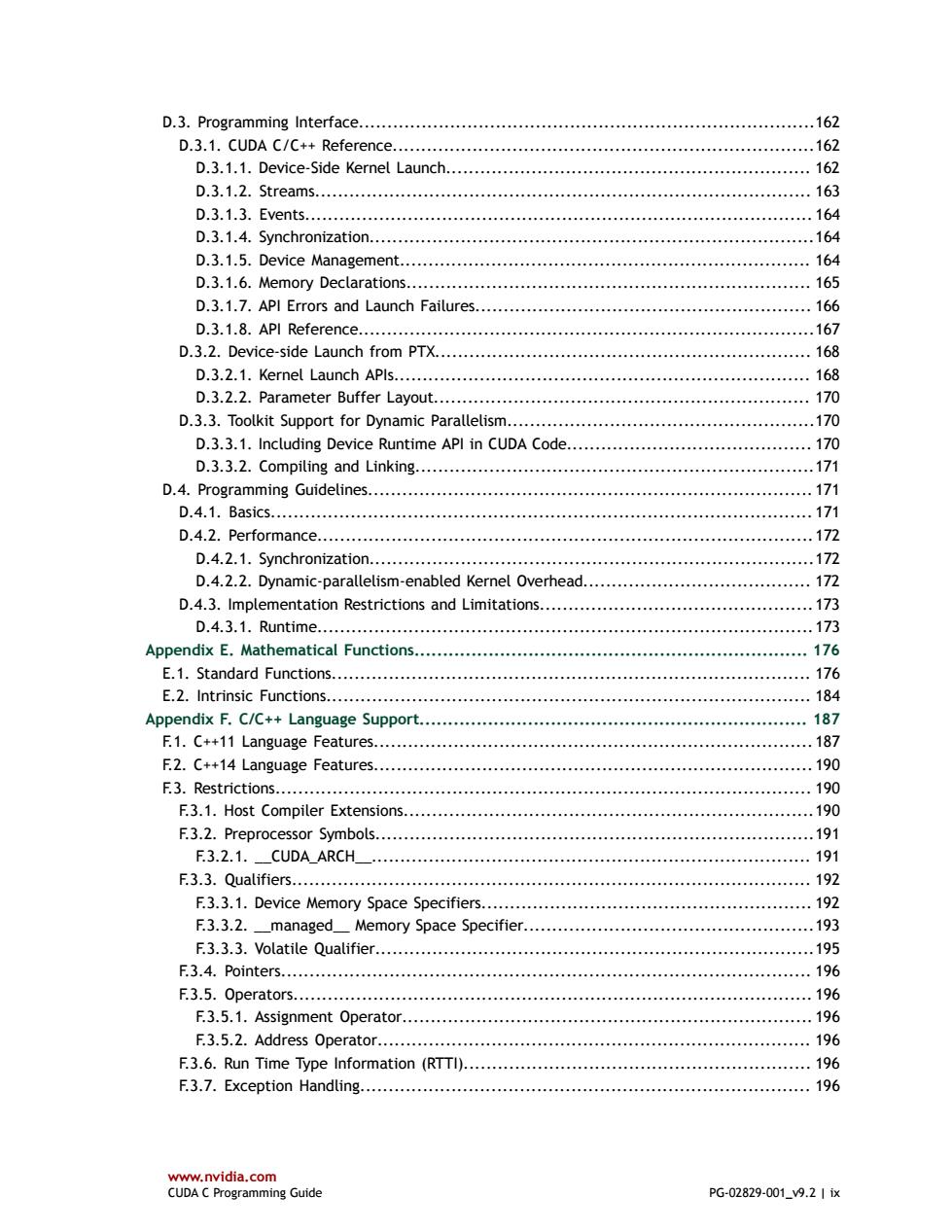
D.3.Programming Interface. ..162 D.3.1.CUDA C/C++Reference.................. 162 D.3.1.1.Device-Side Kernel Launch.......... , 162 D.3.1.2.Stream5..163 D.3.1.3.Events..… .164 D.3.1.4.Synchronization............................ 164 D.3.1.5.Device Management.................. .164 D.3.1.6.Memory Declarations.................. 165 D.3.1.7.API Errors and Launch Failures............ .166 D.3.1.8.APl Reference................. .167 D.3.2.Device-side Launch from PTX................ .168 D.3.2.1.Kernel Launch APls..................... 168 D.3.2.2.Parameter Buffer Layout..................... 170 D.3.3.Toolkit Support for Dynamic Parallelism..... .170 D.3.3.1.Including Device Runtime API in CUDA Code... 170 D.3.3.2.Compiling and Linking................ .171 D.4.Programming Guidelines.................. .171 D.4.1.Basics........... 171 D.4.2.Performance.................T2 D.4.2.1.Synchronization............... .172 D.4.2.2.Dynamic-parallelism-enabled Kernel Overhead...........................172 D.4.3.Implementation Restrictions and Limitations..... .173 D.4.3.1.Runtime.....4473 Appendix E.Mathematical Functions................ ............ 176 E.1.Standard Functions............ 176 E.2.Intrinsic Functions........................... 184 Appendix F.C/C++Language Support............ 187 F.1.C++11 Language Features............... 187 F.2.C++14 Language Features........ ..190 f.3.Restrictions...… 190 F.3.1.Host Compiler Extensions.... ..190 F.3.2.Preprocessor Symbols............... .191 F3.2.1._CUDA_ARCH._… 191 F3.3.Qualifiers...................... 192 F.3.3.1.Device Memory Space Specifiers... 192 F.3.3.2.managed_Memory Space Specifier. .193 F.3.3.3.Volatile Qualifier.......... .195 f3.4.Pointers.… …196 F.3.5.Operators......... .196 F.3.5.1.Assignment Operator............... …196 F.3.5.2.Address Operator.............. 196 F.3.6.Run Time Type Information (RTTI). 196 F.3.7.Exception Handling............ 196 www.nvidia.com CUDA C Programming Guide PG-02829-001_v9.21ix
www.nvidia.com CUDA C Programming Guide PG-02829-001_v9.2 | ix D.3. Programming Interface................................................................................162 D.3.1. CUDA C/C++ Reference..........................................................................162 D.3.1.1. Device-Side Kernel Launch................................................................ 162 D.3.1.2. Streams....................................................................................... 163 D.3.1.3. Events......................................................................................... 164 D.3.1.4. Synchronization..............................................................................164 D.3.1.5. Device Management........................................................................ 164 D.3.1.6. Memory Declarations....................................................................... 165 D.3.1.7. API Errors and Launch Failures........................................................... 166 D.3.1.8. API Reference................................................................................167 D.3.2. Device-side Launch from PTX.................................................................. 168 D.3.2.1. Kernel Launch APIs......................................................................... 168 D.3.2.2. Parameter Buffer Layout.................................................................. 170 D.3.3. Toolkit Support for Dynamic Parallelism......................................................170 D.3.3.1. Including Device Runtime API in CUDA Code........................................... 170 D.3.3.2. Compiling and Linking......................................................................171 D.4. Programming Guidelines.............................................................................. 171 D.4.1. Basics............................................................................................... 171 D.4.2. Performance.......................................................................................172 D.4.2.1. Synchronization..............................................................................172 D.4.2.2. Dynamic-parallelism-enabled Kernel Overhead........................................ 172 D.4.3. Implementation Restrictions and Limitations................................................173 D.4.3.1. Runtime.......................................................................................173 Appendix E. Mathematical Functions..................................................................... 176 E.1. Standard Functions.................................................................................... 176 E.2. Intrinsic Functions..................................................................................... 184 Appendix F. C/C++ Language Support.................................................................... 187 F.1. C++11 Language Features............................................................................. 187 F.2. C++14 Language Features............................................................................. 190 F.3. Restrictions.............................................................................................. 190 F.3.1. Host Compiler Extensions........................................................................190 F.3.2. Preprocessor Symbols.............................................................................191 F.3.2.1. __CUDA_ARCH__............................................................................. 191 F.3.3. Qualifiers........................................................................................... 192 F.3.3.1. Device Memory Space Specifiers.......................................................... 192 F.3.3.2. __managed__ Memory Space Specifier...................................................193 F.3.3.3. Volatile Qualifier.............................................................................195 F.3.4. Pointers............................................................................................. 196 F.3.5. Operators........................................................................................... 196 F.3.5.1. Assignment Operator........................................................................ 196 F.3.5.2. Address Operator............................................................................ 196 F.3.6. Run Time Type Information (RTTI)............................................................. 196 F.3.7. Exception Handling............................................................................... 196
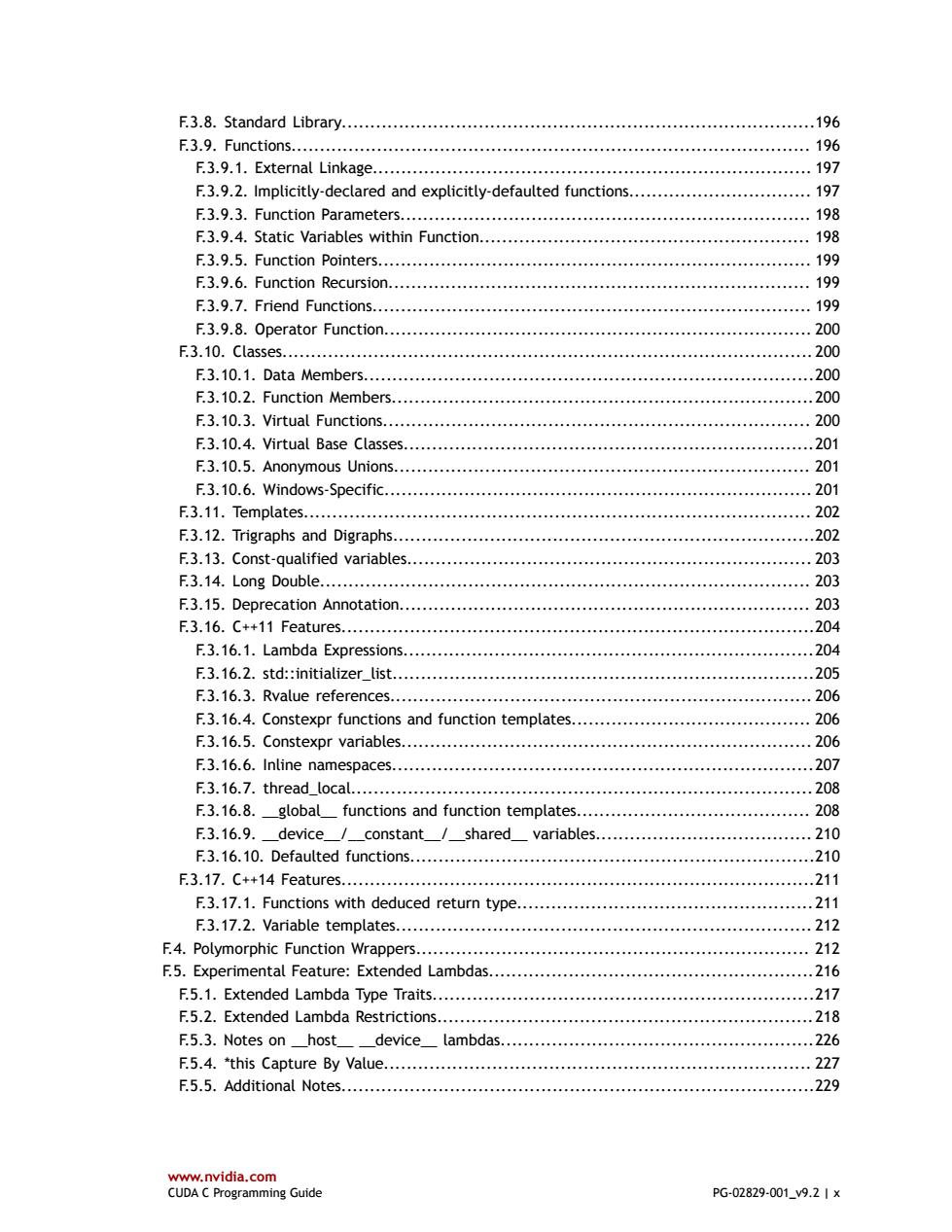
F.3.8.Standard Library...... .196 f3.9.Functi0n5.… 196 F.3.9.1.External Linkage.................... .197 F.3.9.2.Implicitly-declared and explicitly-defaulted functions........................197 F.3.9.3.Function Parameters....... 198 F3.9.4.Static Variables within Function.........198 F3.9.5.Function Pointers.................... ..199 F.3.9.6.Function Recursion............... 199 F.3.9.7.Friend Functions.............. 199 F.3.9.8.Operator Function............. 200 f.3.10.Classes.… .200 F.3.10.1.Data Members........ .200 F.3.10.2.Function Members........... …200 F.3.10.3.Virtual Functions..... 200 F.3.10.4.Virtual Base Classes......... …201 F.3.10.5.Anonymous Unions..... 201 F.3.10.6.Windows-Specific............... 201 F.3.11.Templates................ 202 F.3.12.Trigraphs and Digraphs............... .202 F.3.13.Const-qualified variables.... 203 f3.14.Long Double.… 203 F.3.15.Deprecation Annotation......... 203 F3.16.C++11 Features.......... .204 F.3.16.1.Lambda Expressions................ .204 F3.16.2.std::initializer_list............... 205 F.3.16.3.Rvalue references...................... 206 F.3.16.4.Constexpr functions and function templates.. 206 F.3.16.5.Constexpr variables...................... 206 F.3.16.6.Inline namespaces................... .207 f.3.16.7.thread_local.............. ....208 F.3.16.8.global functions and function templates.... 208 F.3.16.9.device/constant/sharedvariables......................................210 F.3.16.10.Defaulted functions................. 210 F3.17.C++14 Features........... 211 F.3.17.1.Functions with deduced return type... 211 F3.17.2.Variable templates.......................... 212 F.4.Polymorphic Function Wrappers............ 212 F.5.Experimental Feature:Extended Lambdas....... .216 F.5.1.Extended Lambda Type Traits............ .217 F.5.2.Extended Lambda Restrictions................ 218 F.5.3.Notes onhost_devicelambdas..... 226 F.5.4.*this Capture By Value.................. 227 F.5.5.Additional Notes................... ...229 www.nvidia.com CUDA C Programming Guide PG-02829-001_v9.2|×
www.nvidia.com CUDA C Programming Guide PG-02829-001_v9.2 | x F.3.8. Standard Library...................................................................................196 F.3.9. Functions........................................................................................... 196 F.3.9.1. External Linkage............................................................................. 197 F.3.9.2. Implicitly-declared and explicitly-defaulted functions................................ 197 F.3.9.3. Function Parameters........................................................................ 198 F.3.9.4. Static Variables within Function.......................................................... 198 F.3.9.5. Function Pointers............................................................................ 199 F.3.9.6. Function Recursion.......................................................................... 199 F.3.9.7. Friend Functions............................................................................. 199 F.3.9.8. Operator Function........................................................................... 200 F.3.10. Classes............................................................................................. 200 F.3.10.1. Data Members...............................................................................200 F.3.10.2. Function Members..........................................................................200 F.3.10.3. Virtual Functions........................................................................... 200 F.3.10.4. Virtual Base Classes........................................................................201 F.3.10.5. Anonymous Unions......................................................................... 201 F.3.10.6. Windows-Specific........................................................................... 201 F.3.11. Templates......................................................................................... 202 F.3.12. Trigraphs and Digraphs..........................................................................202 F.3.13. Const-qualified variables....................................................................... 203 F.3.14. Long Double...................................................................................... 203 F.3.15. Deprecation Annotation........................................................................ 203 F.3.16. C++11 Features...................................................................................204 F.3.16.1. Lambda Expressions........................................................................204 F.3.16.2. std::initializer_list..........................................................................205 F.3.16.3. Rvalue references.......................................................................... 206 F.3.16.4. Constexpr functions and function templates.......................................... 206 F.3.16.5. Constexpr variables........................................................................ 206 F.3.16.6. Inline namespaces..........................................................................207 F.3.16.7. thread_local................................................................................. 208 F.3.16.8. __global__ functions and function templates......................................... 208 F.3.16.9. __device__/__constant__/__shared__ variables...................................... 210 F.3.16.10. Defaulted functions.......................................................................210 F.3.17. C++14 Features...................................................................................211 F.3.17.1. Functions with deduced return type....................................................211 F.3.17.2. Variable templates......................................................................... 212 F.4. Polymorphic Function Wrappers..................................................................... 212 F.5. Experimental Feature: Extended Lambdas.........................................................216 F.5.1. Extended Lambda Type Traits...................................................................217 F.5.2. Extended Lambda Restrictions..................................................................218 F.5.3. Notes on __host__ __device__ lambdas.......................................................226 F.5.4. *this Capture By Value........................................................................... 227 F.5.5. Additional Notes...................................................................................229